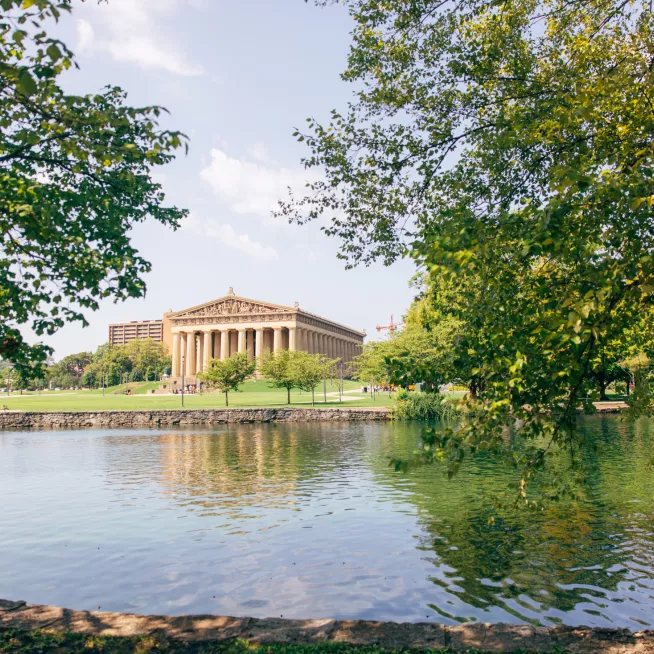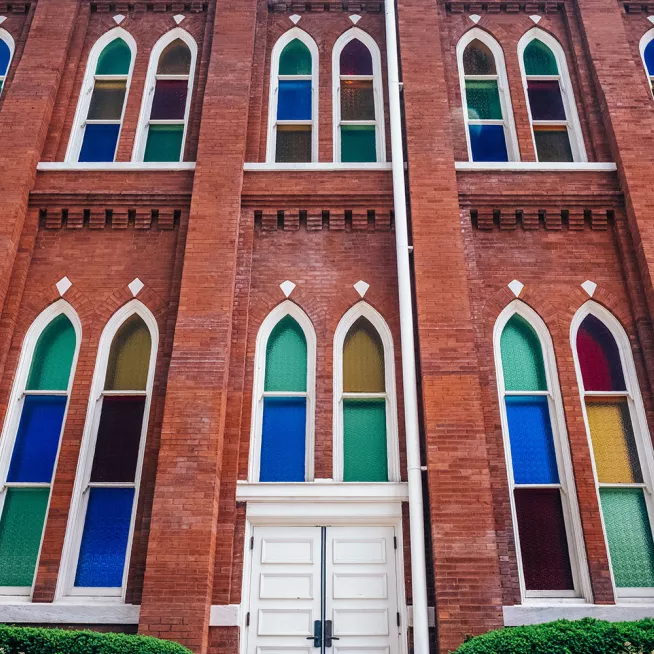Breadcrumb
Exhibition of Fashion and Photography Explores Creative Partnership Between the Designer Lee Alexander McQueen and Photographer Ann Ray
Lee Alexander McQueen & Ann Ray: Rendez-Vous
May 30–August 25, 2024
NASHVILLE, Tenn. (April 3, 2024)—The Frist Art Museum presents Lee Alexander McQueen & Ann Ray: Rendez-Vous, a showcase of garments and photographs that explores the creative partnership between the late British fashion designer, Alexander McQueen, and his trusted friend, French photographer Ann Ray. Organized by Barrett Barrera Projects, the exhibition will be on view in the Frist’s Ingram Gallery from May 30 through August 25, 2024.
Lee Alexander McQueen (1969–2010) redefined contemporary fashion with his extraordinary ability to blend exquisite craftsmanship with imaginative storytelling. Mythologized in his own lifetime, he was characterized as a troubled genius and one of the most visionary designers of his time. The exhibition offers an intimate glimpse into the life and mind of McQueen, who was called Lee by his family and friends, through a selection of photographs taken over the course of 13 years by Ann Ray (b. 1969). With exclusive, unfettered access to McQueen’s world, Ray captured everything from contemplative moments in the design studio to the organized chaos backstage at runway shows. In total, she shot 43 collections, creating a massive body of work and an indelible record of McQueen’s process. At various moments during their collaboration, the designer and the photographer would have what Ray called “rendez-vous,” or “weird, unexpected. warm, essential meetings.”
The exhibition features 60 dress objects, including ready-to-wear, one-off samples, and examples of haute couture that span the arc of McQueen’s career, and 65 photographs hand-selected by Ray from her archive of over 32,000 negatives. Included among the dress objects are 10 garments that McQueen gifted to Ray, as well as 13 important garments that are exclusive to the Frist’s presentation, all of which are sourced from Barrett Barrera Projects in St. Louis, Missouri, the world’s largest private collection of McQueen’s works.
Seen together, this selection provides an opportunity to reexamine the life and legacy of a beloved but widely misunderstood figure and to disentangle the person from the persona. “While there have been other exhibitions of McQueen’s work, including the attendance record-breaking Savage Beauty project at the Metropolitan Museum of Art in New York in 2011, one year after his death, the unprecedented inclusion of Ray’s photographs creates a rendez-vous in which new and perhaps more truthful narratives emerge,” writes Frist Art Museum senior curator Katie Delmez.
To tell the story of both artists, the exhibition is organized into five sections of McQueen’s garments paired alongside 12 thematic sections of photography selected and organized by Ray herself. Entering the galleries, visitors first learn about how the two artists’ creative partnership began shortly after McQueen’s appointment in 1996 as creative director at Givenchy, one of Paris’ oldest and most storied couture houses, at age 27. Already aware of his legacy and responsibility, McQueen wanted someone to capture the fleeting moments of his work. Ray, who had worked with Givenchy, became that person. With a partnership built on trust and without a formal contract, Ray agreed to document McQueen’s process in exchange for unrestricted access and gifts of garments, a selection of which leads the exhibition.
The next four groupings of McQueen’s garments are divided into chronological chapters that trace his career moves, iconic collections and runway shows, and final years. McQueen graduated from the prestigious fashion program at Central Saint Martins in 1992, and with the support of the socialite and fashion editor Isabella Blow, founded his eponymous label, and honed his talents as a storyteller in early collections on a shoestring budget.
At Givenchy’s Georges V atelier, Ray watched McQueen, who had learned the craft of English tailoring as an apprentice on London’s storied Saville Row, immerse himself in the complex art of couture dressmaking. Having previously worked mainly as an editorial photographer, Ray, too, was also challenging herself as documentary photographer. Upon seeing Ray’s early photographs, McQueen remarked, “You’re observing everything,” to which she replied, “I do. Just like you.”
Although this period of McQueen’s life was very demanding and saw personal struggles, it was also a time of great success and fashion history in the making. “His runway shows became more theatrical, his references more eclectic, and his silhouettes more extravagant and exaggerated,” writes Delmez. Ray’s photograph Insensé II captures a now iconic moment from McQueen’s spring/summer 1999 show, No. 13: The model Shalom Harlow staggered and swayed on a rotating platform to a soundtrack of Camille Saint-Saëns’s “Le cygne” (“The Swan”) as two almost predatory looking robots sprayed her white gown with black and neon green ink. McQueen also addressed topics as varied as the transience and impermanence of beauty in the spring/summer 2001 collection Voss and the condemnation of religious zealotry during the Salem Witch Trials with a defiant feminist subtext in In Memory of Elizabeth Howe, Salem, 1692 (autumn/winter 2007).
The final chapter of McQueen’s brief but remarkable life was marked by great loss with the deaths of his friend and supporter, Isabella Blow, in 2007, and his beloved mother, Joyce McQueen, in early 2010. Yet his resilient creative drive continued in a tribute to Isabella Blow. Spring/summer 2008’s La Dame Bleue saw McQueen return to his roots through the craft of tailoring and he and Blow’s mutual love of birds. Likewise, in Ray’s photographs, wings and feathers are central and significant recurring motifs. McQueen’s interpretation of Plato’s allegory of the lost city, spring/summer 2010’s Plato’s Atlantis, is a prophetic warning about the devastating effects of ecological destruction and is widely considered one of his most important collections.
Lee Alexander McQueen died by suicide on February 11, 2010. As the world reeled from the loss of a singular creative mind, the twenty-first-century global fashion machine that McQueen had helped create, but at times also felt exploited by, continued to grow and evolve. The Alexander McQueen label, under the creative direction of trusted confidant and former head of womenswear Sarah Burton until recently and now Séan McGirr, remains one of the world’s most sought-after luxury brands.
Exhibition Tour
Crocker Art Museum: December 18, 2022–April 2, 2023
Columbia Museum of Art: October 7, 2023– January 2, 2024
Frist Art Museum: May 30–August 25, 2024
Grand Rapids Art Museum: October 5, 2024–January 11, 2025
Opening Program
Thursday, May 30
Conversation: Ann Ray with Kelly Peck and Seth Feman
6:30 p.m.
Auditorium
Free; first come, first seated
Join Ann Ray, Kelly Peck, Barrett Barrera Projects curator, and Seth Feman, Frist Art Museum executive director and CEO, for this intimate conversation about the exhibition and Ray’s artistic practice and relationship with McQueen.
Exhibition Credit
Lee Alexander McQueen & Ann Ray: Rendez-Vous is organized and produced by Barrett Barrera Projects.
Supporter Acknowledgment
Platinum Sponsor: HCA Healthcare/TriStar Health
Education and Community Engagement Supporter: Windgate Foundation
Hospitality Sponsors: The Union Station Nashville Yards and Grand Hyatt Nashville
Spanish Translation Sponsor: Center for Latin American, Caribbean, and Latinx Studies at Vanderbilt University
The Frist Art Museum is supported in part by The Frist Foundation, Metro Arts, the Tennessee Arts Commission, and the National Endowment for the Arts.
###







